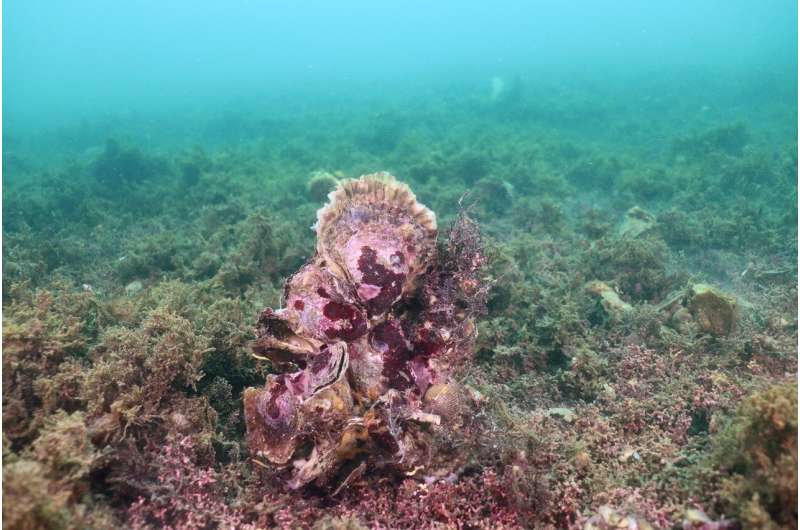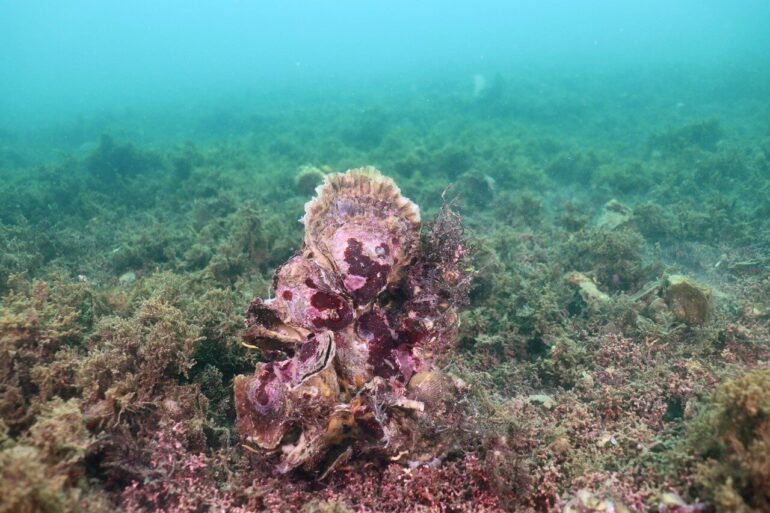Oysters once formed extensive reefs along much of Europe’s coastline—but these complex ecosystems were destroyed over a century ago, new research shows. The paper, published in the journal Nature Sustainability, is titled “Records reveal the vast historical extent of European oyster reef ecosystems.”
Based on documents from the 18th and 19th centuries, the study reveals that European flat oysters formed large reefs of both living and dead shells, providing a habitat supporting rich biodiversity.
Today these oysters are mostly found as scattered individuals—but the researchers found evidence of reefs almost everywhere, from Norway to the Mediterranean, covering at least 1.7 million hectares, an area larger than Northern Ireland.
The research was led by the University of Exeter and The University of Edinburgh.
Native oyster reefs created their own ecosystems, full of a diverse range of underwater life—supporting a greater number of species than surrounding areas.
In addition to creating homes for the almost 200 recorded fish and crustacean species, the oysters also played a vital role in stabilizing shorelines, nutrient cycling and water filtration—with a single adult oyster filtering up to 200 liters of water a day.
Restoration projects are under way across Europe—and small-scale habitat restoration, such as The Wild Oyster Project, led by ZSL and partners, are key stepping stones to the return of these vital ecosystems on an international scale.
However, restoration efforts need to be scaled up with support from governments and other decision makers across the continent.

Oyster reefs have largely disappeared, but clumps of oysters can still be found. © Stephane Pouvreau / Ifremer
“Human activities have affected the ocean for centuries,” said Dr. Ruth Thurstan, from the University of Exeter and part of the Convex Seascape Survey, an ambitious five-year project examining ocean carbon storage.
“This makes it difficult to discover what our marine ecosystems used to look like, which in turn hampers conservation and recovery.
“Few people in the UK today will have seen a flat oyster, which is our native species. Oysters still exist in these waters but they’re scattered, and the reefs they built are gone.
“We tend to think of our seafloor as a flat, muddy expanse, but in the past many locations were a three-dimensional landscape of complex living reefs—now completely lost from our collective memory.”
Due to their economic and cultural significance, oysters feature in historical records including newspapers, books, travel writing, landing records, nautical charts, early scientific investigations and interviews with fishermen.
“By combining descriptive accounts from a range of historical sources, we can build a picture of our past seas,” said Dr. Thurstan, who is mapping past ocean changes as part of the Convex Seascape Survey.
“The greatest concentration of oyster reefs we found was in the North Sea.”
Records show extensive reefs existed along the coasts of modern France, Denmark, Germany, the Netherlands, the Republic of Ireland and the UK.

Whitstable, Kent 1) Boats Going Out 2) Dredge 3) Oyster Bags 4) Dredging 5) Landing Oysters. © Illustrated London News Ltd / Mary Evans
“Oyster reefs are slow to develop, with layers of new oysters building up on the dead shells of their predecessors, but their destruction through overfishing was relatively rapid,” said Dr. Philine zu Ermgassen, honorary researcher at the University of Edinburgh.
“This has caused a fundamental restructuring and ‘flattening’ of our seafloors—removing thriving ecosystems and leaving an expanse of soft sediment behind.
“Thanks to this historical ecology research, we are now able to quantitatively describe what oyster reefs looked like before they were impacted, and the spatial extent of the ecosystems they formed.
“These were huge areas that were thickly crusted with oysters and crawling with other marine life.”
The research team was made up of more than 30 European researchers from the Native Oyster Restoration Alliance.
More information:
Records reveal the vast historical extent of European oyster reef ecosystems, Nature Sustainability (2024). DOI: 10.1038/s41893-024-01441-4
Provided by
University of Exeter
Citation:
Study reveals oyster reefs once thrived along Europe’s coasts—now they’re gone (2024, October 3)



